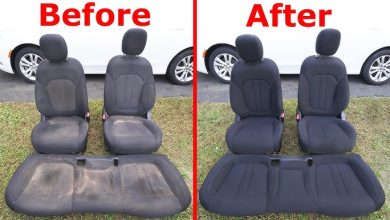How to Permanently Restore Black Plastic Trim DIY
As car owners, we know how frustrating it can be when our once shiny black plastic trim starts fading, cracking, or looking dull. Thankfully, there are some effective methods we can try at home to restore faded plastic trim without spending a fortune.
How to restore black plastic bumpers
One of the most common plastic pieces that fade is the front or rear bumper. Over time, exposure to UV rays from the sun can break down the pigments in black plastic, leaving it looking grey and worn. The good news is with a little TLC, we can restore the depth and shine.
The first step is to clean the bumper thoroughly with soap and water to remove any dirt, grime, or old wax buildup. This will ensure your restorer can fully bond to the plastic’s surface. Next, use a plastic bumper restorer like Meguiar’s or Mother’s. Apply a liberal coating with a microfiber cloth and allow it to fully dry as directed. For a deeper restoration, you can also lightly wet sand the bumper with 800-1500 grit sandpaper first to remove the faded outer layer before applying the restorer.
With regular top-ups every 3-6 months, your bumper should stay looking like new for years to come. Be sure to apply quality car wax over the restorer to help protect it from future fading. With some patience and elbow grease, a faded bumper can be brought back to life!
How to make faded plastic look new
Aside from bumpers, other common plastic trim pieces like mirror covers, side mouldings and door handles can fade over time too. The process is very similar to restore bumpers. Gently wash the piece with mild soap and water to remove surface contaminants. Then, use fine grade (800-1500) wet/dry sandpaper to lightly scuff the faded plastic’s outer layer. This preps the surface for your restorer.
Apply your chosen plastic restorer like Meguiar’s PlastX or Mothers Back to Black and let it fully cure as directed. For interior pieces, wiping it down with a microfiber cloth andallowing it to air dry works well. Exterior pieces may require more liberal coats applied with a foam applicator. Regularly re-apply your restorer every few months as a maintenance step. With some gentle scrubbing and restorer magic, aged plastic can look showroom-new again!
Best black plastic restorer
When it comes to restoring faded black plastic trim, some products simply work better than others. Two leading restorers that really get the job done are:
- Meguiar’s PlastX Heavy Duty Rubber and Vinyl Restorer: Specially formulated to deeply condition tough rubber and vinyl surfaces while restoring vibrant black color. Leaves a long-lasting, smooth satin finish.
- Mothers Back to Black Restorer: Renowned for its ability to penetrate deep into plastic pores to revive faded or worn trim. Creates a rich, OEM-like sheen without leaving a sticky or slippery residue.
Both are easy to use, contain UV filters for continued protection, and produce excellent restoration results with just a few applications. For best results on heavily faded pieces, I’d recommend lightly wet sanding first before applying 2-3 thin coats as directed on each product. Both are must-have items for any car care toolbox!
How to make homemade plastic restorer
Those looking for a budget-friendly DIY option can certainly experiment with making their own plastic restorer blend at home. The key ingredients that restore plastic’s condition and color include:
- Vaseline/petroleum jelly: Deeply moisturizes and conditions cracked or dry plastic.
- Black shoe polish: Adds rich black pigment to fade plastic trim color.
- Lemon oil: Helps break down oxidation and UV damage while leaving a slick shine.
Simply mix 1 part each of vaseline, shoe polish and lemon oil in a small jar. Apply a thin layer with a clean rag and buff well. Reapply every few weeks for maintenance and enjoy savings over store-bought products. Play around with ratios to suit different materials. With the right formula, homemade can match pricey brands.
How to permanently restore black plastic trim diy car – FAQs
Does black plastic restorer work?
When applied properly, high-quality plastic restorers like Meguiar’s or Mothers definitely work to restore faded black plastic trim. For best results, gently prep the surface first by washing and lightly wet sanding away oxidation. Then, apply multiple thin coats as directed, buffing between each layer. With regular reapplication every 3-6 months as a protectant, restored trim can look showroom-new for years.
Can I use tire black on plastic trim?
In some cases, tire blackening products designed for wheels may work temporarily to cover faded plastic trim. However, they don’t restore plastic’s condition like a dedicated restorer and may peel or flake off more easily with heat cycles. Stick with purpose-made plastic or vinyl restorers formulated with UV filters for long-lasting repair without compromises.
How do you keep black plastic trim from fading?
To protect restored trim from future fading, apply a quality car wax or sealant specifically made for plastics after restoration. Reapply the protective layer every 3-6 months with washes in between. Also consider using a trim cover film that blocks 99% of UV rays causing damage. Park in shade when possible. Proper maintenance is key in keeping black plastic looking new for years to come.
Will WD40 restore black plastic?
While WD-40 is great for cleaning and protecting metal surfaces, it’s not particularly effective at restoring faded plastic trim on its own. WD-40 lacks the rich pigments and UV-absorbing agents needed to repair oxidized color. It may temporarily disguise aging but won’t condition plastic at a molecular level like dedicated restorers. Stick with products formulated for automotive-grade rubber and vinyl for best, long-lasting effects.
What causes black plastic to fade?
The main culprit behind faded black plastic trim is ultraviolet (UV) light rays from direct sunlight. Over time, constant UV exposure breaks down plastic’s outer polymer layer and underlying pigments that provide a rich black color. Heat cycles from radiant car interiors only serve to accelerate this photodegradation process. Environmental factors like air pollution, acid rain, and industrial fallout can speed fading too by abrading exterior surfaces with abrasives. Proper maintenance is key to slowing these ravages of time and returning plastic to like-new condition.
Can you use Vaseline to restore plastic?
While not a one-step restoration solution on its own, a small amount of Vaseline or petroleum jelly can help condition cracked or dried-out plastic trim when incorporated into homemade restorers. Its emollient properties deeply moisturize plastic polymers for flexibility. Used alone though, it won’t restore much lost color from prolonged UV damage. For full restoration, including rich pigment repair, products with added conditioning agents and UV absorbers are most effective.
How do you make plastic shine like glass?
To get vehicle trim and plastics gleaming like mirrored glass, the key is applying multiple thin coats of a high-quality plastic polish or sealant designed for automotive exteriors. Meguiar’s Mirror Glaze plastic polish is a favorite for its slick, water-clear shine. Compound tougher oxidation first if needed. Always clean and decontaminate surfaces first before applying 2-3 coats as directed, buffing well between each layer. Regular washing with a pH-neutral soap and occasional polish top-ups keep restored trim flawless for seasons to come.



